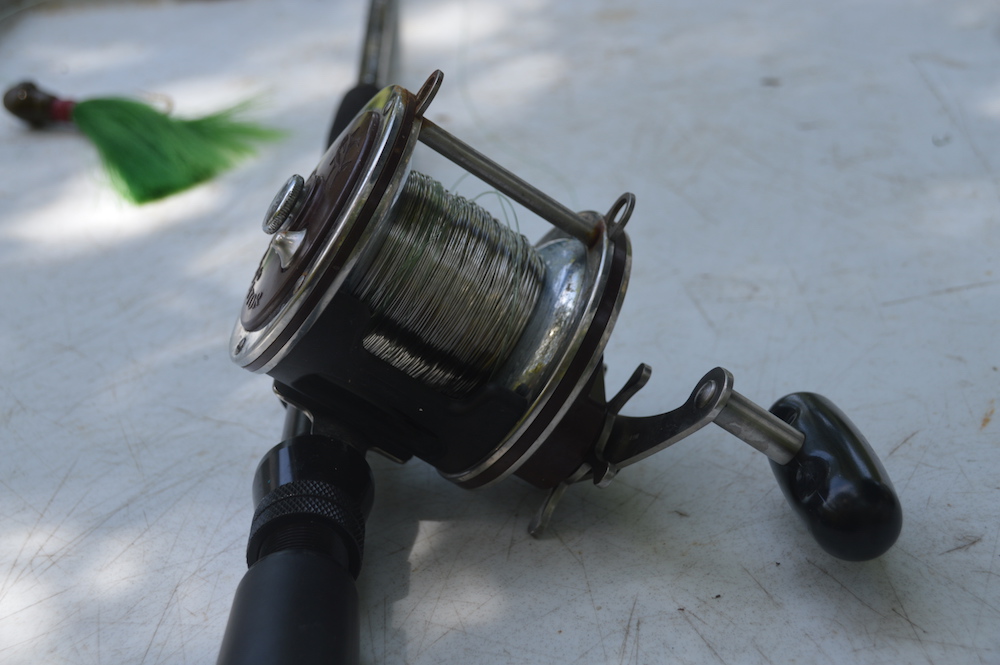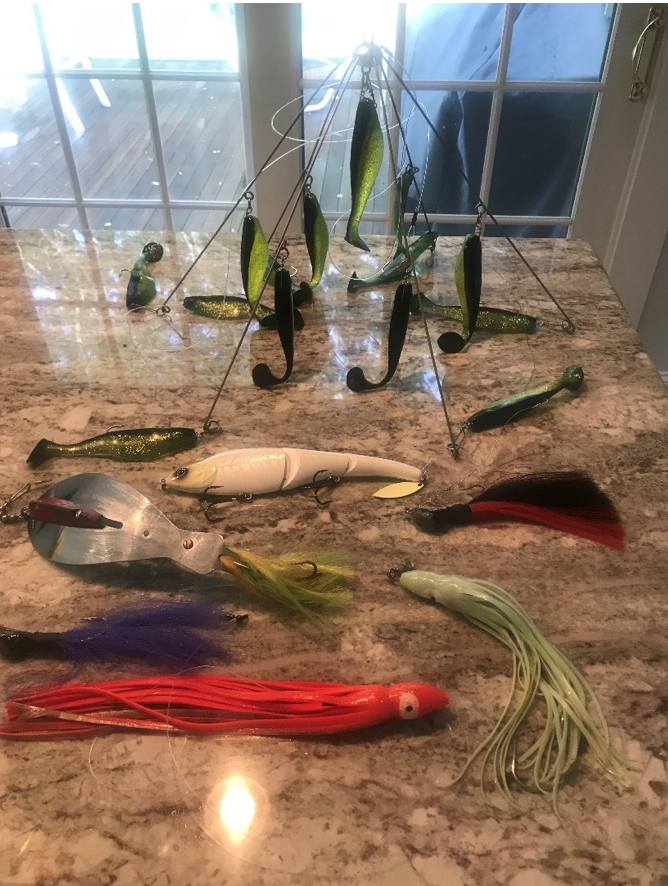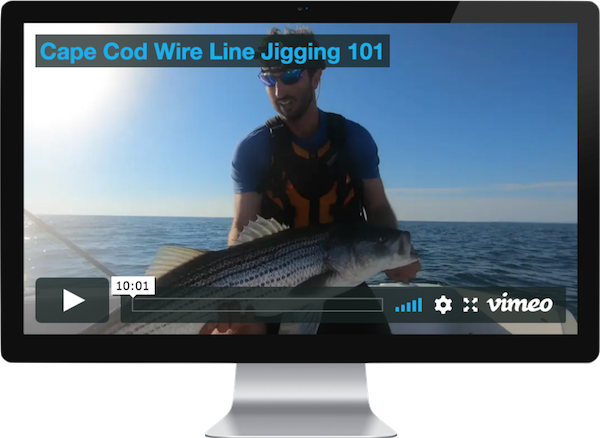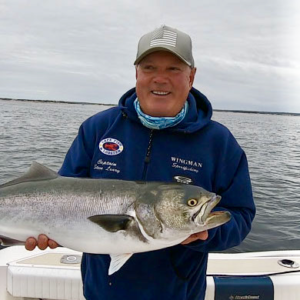
Captain Steve Leary
Wingman Sportfishing
There is no doubt each time I engage folks in conversation related to fishing with wire line, I brace myself for the standard onslaught of old or newer more “colorful” expletives related to using that “x*&%#>@” crap!
Sure, I’ll admit wire is not very forgiving if not handled properly. Wire can create some incredible birds nests, and then there is wire's ever present desire to kink, and wire's memory coils.
However, wire does bring with it a set of advantages and flexibility that other lines do not! In this post I would like to share with you the most important lessons I have learned in my time spent wire line fishing on Cape Cod.
More...
Key Variables: How Much Wire Is In The Water & How Deep The Lures Are Running

In this recent post I relayed the benefits of keeping a log and tracking variables that effect your catch.
How much wire line is in the water and how deep your lures are running are two critical variables that directly impact your ability to catch big stripers.
My reels are set up with either 300’ or 400’ of 60lb wire which gives me the ability to effectively fish in 15’ to over 80’ of water.
Aboard Wingman our setups have hi-vis dacron splices (orange, yellow or pink) at 150’, 300’, 350’ and 400’ to indicate how much line is out.
The splices are made with simple haywire twists on the wire and Albright knots to attach the dacron.

Spooling up my wire in this fashion helps make it easy for me to track how much line I have in the water, and how deep I am fishing my lures.
On another note, it's always fun to inform a charter customer (whose arms are burning while cranking in a big bass) that they only have another 150’ or 300’ feet to go, as those splices appear on the surface.
Typical rule of thumb is 10’ of lure depth per hundred feet of line deployed. Depth is also affected by boat speed, lure weight and type.
When I first began using wire, I’d find areas at various depths with a sandy bottom and do test trolls with varying line depth, lures and boat speed.
With each lure type, I’d vary line depth and boat speed (anywhere between 2-7 knots, which are typical wire line trolling speeds) until I felt the lure touch bottom.
Although time consuming, this method provided me with a valuable baseline I still use aboard Wingman every day.
How It Can Pay To Be Flexible In Your Approach
Using wire line gives you flexibility that other lines do not.
As shown below, there are many lure types you can use with wire to match the bait the bass are feeding on.

Any of the above lures fished on wire will easily get down deep where the bigger bass like to hang out, especially during the summer.
A productive tactic we use aboard Wingman is to “go hunting” in the areas the bass have been frequenting. When hunting, we typically run 2-3 flatlines with various colored hoochies at 6-7 knots.
This enables us to cover a lot of sea surface and locate fish via the sounder and or hookups. Should we come upon a “pile” of fish not interested in the hoochies (which is rare) we’ll next try approaching them from various directions.
Should that not work, the hoochies setups are stowed and we switch to other wire setups with bottom jigs. As we approach the waypoints where the fish are sitting, I drop the boat speed down, the jigs are deployed, and bounced along the bottom.
Typically, it only takes a few tugs on the rod before hookups occur.
Wire Line Trolling
Tackle & Equipment
On my boat I use Diawa 400H reels when trolling wire. Penn 113H and Shimano TLD 20s work great as well. I have TLD 20s on my rods with Spectra line and really like the lever drag configuration.
My 6’8”wire rods are custom made by Dan Hannon from Salt Shaker Sportfishing here on the Cape. There are many great over the counter rods available.
The Team at Goose Hummock in Orleans will be able to set you up with excellent rod/reel combos for wire.
In Conclusion
Fishing with wire line takes some extra work and attention. However it's been my experience the benefits of wire far outweigh the added work when it comes to putting big bass on the deck.
Despite wire line's bad rep, when I ask my customers what it is they’d most like to learn, often the response is an enthusiastic “how to fish with wire!"
I hope this post has helped you better understand this very effective method for catching striped bass, especially during the summertime on Cape Cod.



What do you mean when you say flatlines?
Hi Jill,
Great question!
In general, flat lining is a technique where baits or lures are trolled directly from the rod tips vs up on the outriggers or center rigger. My reference to flat lining is the use of out rodders to position the starboard and port rods lower to the gunnels, at approximately right angles to the hull vs straight off the transom, and in a more horizontal position out over the water. The purpose is two fold, first it spreads the lures further apart, approximately 2X the rod length, which improves maneuvering and tighter turning without line tangles. Secondly, the line enters the water closer to the boat and results in the lure running deeper for a given length of line. I highly recommend attaching safety lines to the rods when using this approach.
Other flat line methods I’ve used when trolling for tuna are attaching outrigger release clips to the center of the transom or aft on the gunnels and running lines through the release clips. This enables running the bait or lures or closer to the boat and in the prop wash if desired.
A similar simpler approach can be accomplished by using heavy (Size 62) rubber bands. Here the running line is attached to the reel handle via a loop with the rubber band. When a strike occurs the band snaps releasing the line.
I hope you’ve found this additional information helpful. Please feel free to contact me with any additional questions.
Tight Lines!
Captain Steve Leary
Wingman Sportfishing
I Fish each nite w wire leaders, its just easier for me and blues have been around,i remove the big clips and put my own on,never has failed me catchn/landing big cows…i have to remember to change over to mono at daybreak. Great article!
Hi Mark,
Thank You!
No doubt wire leaders keep you going when the Blues are around.
Using wire as the main line, I run 4-5’ of fluorocarbon or mono to the lures given the lure body protects against cut offs by blues.
Bottom jigs are the only setup where I run the wire right to the lure. This is to enhance jig action and maximize positive hookups.
Keep up the great work finding those cow bass!!!
Captain Steve Leary
Wingman Sportfishing
Thank you Capt. Steve for all the info. Ryan, besides the life vest that you are wearing what other safety features would you suggest when fishing solo on a boat.
Hey Jake.
I’m glad you found the info helpful.
Please feel free to contact me with any questions on this or other topics.
Captain Steve Leary
Wingman Sportfishing
I keep a handheld VHF marine radio in one pocket of that live vest, and I keep a Garmin Satellite Communication Device in my other live vest pocket – just in case.
Thank you for the informative post Steve. ?
Last June one of your charter friends put on a clinic with wire, jigging up 20+ pound bass on each pass while I got skunked trolling tubes on lead core. That was the last time I left the dock without having a wire line setup onboard.
I would much rather be catching fish on wire, then not catching fish at all! Thanks again for the info!
Thanks Ryan,
Happy to share the info.
Using wire may be viewed as
“Old School” by some, but it puts fish on the deck time and time again!
Steve
Steve,
Your attention to detail and meticulous preparation has served you and your customers well – I have already benefited from your skills.
Thank you,
Mike
Mike
Thanks so much!
I always enjoy having you aboard and am looking forward to our next trip.
Captain Steve Leary
Wingman Sportfishing